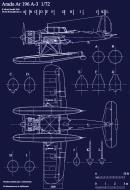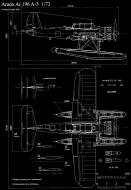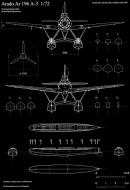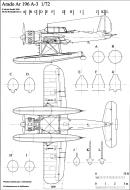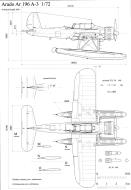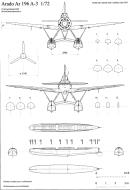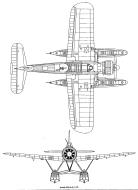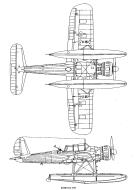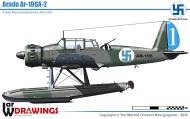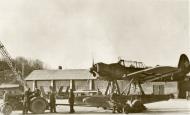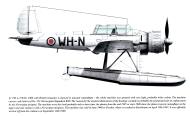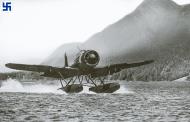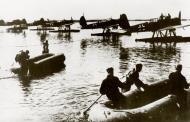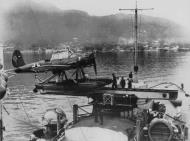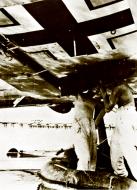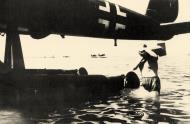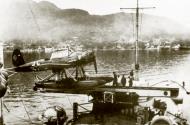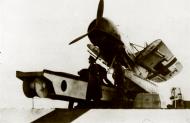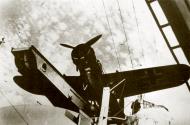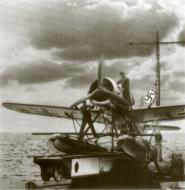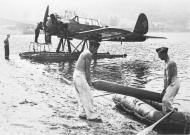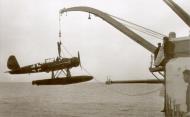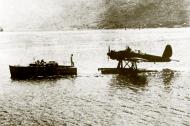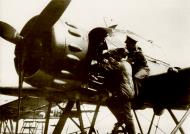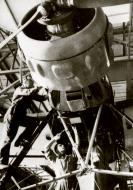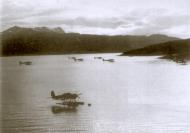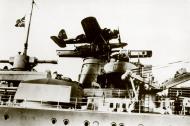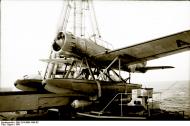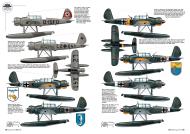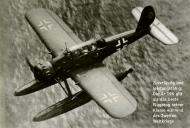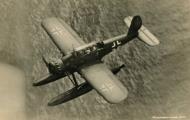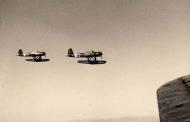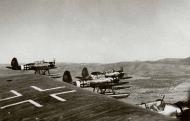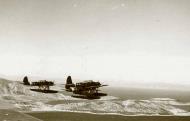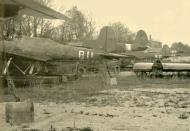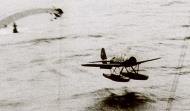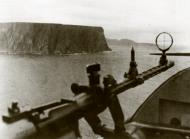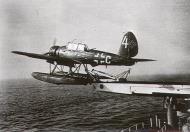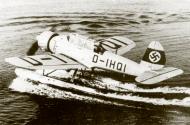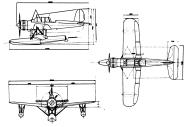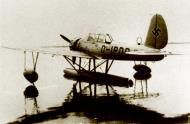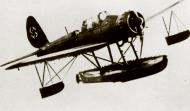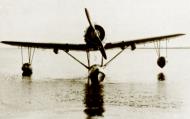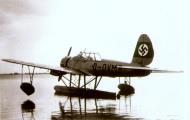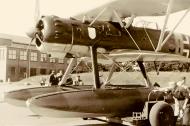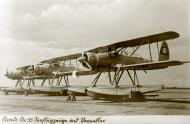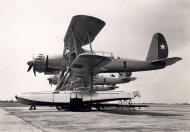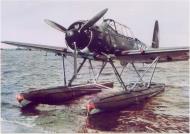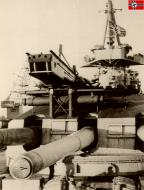Arado Ar 196 seaplane
Role: Reconnaissance aircraft
Manufacturer: Arado Flugzeugwerke
Manufactured: Warnemünde factory, Germany
Designer: Walter Blume
First flight: May 1937
Introduction: November, 1938
Primary user: Kriegsmarine
Foreign users: Bulgarian Air Force, Finnish Air Force, Romanian Air Force
Produced: 1938–44
Number built: 541
Arado Ar 196
The Ar 196 was a shipboard reconnaissance aircraft built by the German firm Arado starting in 1936. The next year it was selected as the winner of a design contest, and became the standard aircraft of the Kriegsmarine (German Navy) throughout World War II.
Design and development
In March 1935, the German Ministry of Aviation (Reichluftfahrtministerium) issued a requirement for a new ship launched scout - to replace the ageing and poorly designed He 60. Despite being powered by a 660 hp BMW V1 inline engine the aircraft suffered from poor performance and a very heavy airframe, with an empty weight of 2700kg. Heinkel and Arado both proposed designs, which were granted development contracts. Arado's Ar 95, and Heinkel's He 114 were both twin floats and powered by the BMW 132 radial engine, the RLM preferring Heinkel's aircraft. Arado was advised to rework the Ar 95 as a universal naval aircraft for export, with two or three seats and either floats or wheels, such as the Ar 195 torpedo bomber. The Ar 95 took to the skies for the first time on December 6th, 1936 - and ultimately only small numbers were built. Despite this, the Ar 95 continued to serve in the Eastern front until 1944 - so evidently there was little wrong with this aircraft - designed by Dipl-Ing Walter Blume. Blume, a world war I ace, must have been unhappy with the direction the Ar 95 took or the fact it lost out to the He 114, as during 1936 he continued to work on the design. He eventually ended up with a smaller and lighter low wing monoplane, which he submitted on the 12th August 1936, to which 24 representatives of the RLM would come to Warnemünde three weeks later to inspect a mock up of the proposed design. The he 114, in the meantime, was quickly losing favour as it became clear it was barely an upgrade over the He 60 it was intended to replace. Indeed, most ships equipped with the He 60 never even received their He 114s. Written around the new Arado design, a fresh requirement was issued to the aircraft industry by the RLM in October, to which three new aircraft were proposed. A floatplane variant of the Go 145 trainer (Gather Waggonfabrik) and the Do 22 (Dornier) were immediately rejected, being unfit for combat and simply too large for shipboard use respectively. Focke-Wulf came up with an all-new design, the Fw-62 biplane, which was selected for development, along with Blume’s Ar 196 monoplane.
Both aircraft were ordered in two prototype variants - two with twin floats, and two with a single central float and twin outrigger floats. It was believed that the latter could have advantages with landing in rough seas, by absorbing the blows to the fuselage and not to the wings. The first Ar 196 prototype with twin floats flew on 1st June 1937, and was found to have favourable characteristics in the water and in the air, along with surprising manoeuvrability. The Fw 62, obviously at a disadvantage to the more modern Ar 196, didn’t fly until October of the same year - though it was found that despite its conservative design philosophy, the aircraft was stable, good to fly and a competent platform for shipboard use. November 1938 saw the first tests with the outrigger float configuration, and it did not seem to confirm the theoretical advantages the RLM has presumed. The central float did allow slightly better landing performance, though it was judged that this was outweighed by its inferior manoeuvrability whilst taxiing.
20th July 1939 saw the first of 20 Ar 196 A-1s were delivered to the Travemünde test centre. Being armed with only a single 7.92mm MG 15 for the observer, though equipped with racks that would be capable of carrying up to two 50kg bombs. These early 196s were powered with 880 hp BMW 132K engines with three-bladed Schwarz propellors. One of these prototypes suffered an engine mount collapsed on landing, which fell into a fuel line in one of the struts and ignited a fire. Both crew managed to bail from the burning aircraft, though the cold ocean quickly smothered the flames. This serious issue led to the A-2s, which had some structural improvements, equipped 20mm MG FF cannon in the wings, a 7.92mm MG 17 machine gun in the cowling, and an uprated BMW 132K engine now capable of outputting 960 hp under takeoff power. The A-3 (coming after the mis-numbered A-4) saw enlarged fuel tanks in the pontoons and further strengthening to the structure. The A-5 model, being the final production model from 1943, fitted MG FF/M cannon with extended magazines, armour plating for the crew, and an upgraded BMW 132W engine capable of outputting 1,050 hp under maximum power. MG 81Z defensive machine guns were retrofitted to all existing 196 models to increase defensive firepower. 15mm MG 151 or MG 131 were also often retrofitted to 196s in the later war, replacing the 20mm cannon in favour of more modern weaponry.
Overall, 541 Ar 196s (15 prototypes and 526 production models) were built before production ended in August 1944, about 100 of these from SNCA and Fokker plants.[1]
The Ar 196C was a proposed aerodynamically-refined version. The Ar 196C project was cancelled in 1941.
Operational history
The aircraft had a rich operational history in all the major theatres of war, from the Western battles against the RAF, to the Mediterranean and the Eastern front. It was hugely popular with its pilots, being of fairly simple and rugged construction and considered to be a reliable aircraft. On August 15th 1940, during the legendary Battle of Britain, a single Ar 196 was bounced by ten spitfires. During the dogfight that ensued, the German seaplane managed to shoot down one spitfire before going down herself, severely damaged. The pilot, Staffelkapitän Hauptmann Gerrit Wiegmink, survived the crash, though the observer had already been killed during the dogfight.
The Arado saw a fair amount of export orders - Bulgaria, Finland and Romania operating them. Bulgaria ordered nine A-3 models in 1943, used by the 161 Jato unit and operated on the Eastern front in conjunction with the Luftwaffe. These aircraft continued to serve until 1947, one is preserved and on display at the Bulgarian Air Force Museum. Finland loaned three Ar 196s that flew in German markings GA+DO (A-2), A3+AC and A3+BC (both A-3s). In 1943 Finland ordered a further 12 A-3s, all of which went into service with Lentorykmentti 5, allocated to TLe.Lv.12 and TLe.Lv.14 (No. 12 and No. 14 Reconnaissance squadron). These Finnish aircraft were upgraded to the A-5 standard during the Continuation War, and were fitted with extra shackles to hold up to four 100kg bombs, a modification unique to Finnish 196s. A popular field modification with No. 12 was also to remove the 7.92m MG 17 cowling machine gun in favour of the 12.7mm LKk/42. The three loaned Ar 196s were returned to Germany in September 1944 after hostiles with the Soviet Union came to an end, purchased models continued to serve until the end of the war.
A number of Arados were captured and put into service throughout the war, the first of which was the aircraft from the German Cruiser Admiral Hipper which was captured in Lyngstad, Eide by Høver M.F.11 floatplanes from Trøndelag on 8th April 1940. The aircraft was then towed to Kristiansund and painted in Norwegian markings. In April the following year, the Hellenic Navy would capture a Bordfliegergruppe Arado 196 which had been forced to land by Piraeus after having suffered a ruptured fuel line. The Arado was evaluated, painted in Hellenic colours and hurriedly pressed into service with the RHAF. It would be one of the few Greek aircraft to escape to the middle east before the Capitulation. In the middle east it was used as a supplementary aid to the 13th Light Bomber Squadron, but remained largely unused for inland operations. At some point is was re-engined with a Wright R-1820-60 Cyclone due to a lack of spare parts. In October 1944, after the withdrawal of Germany from Greece, an Arado Ar 196 A-5 was discovered in Skaramagas, where it had been left after sustaining heavy damage in February of the same year. This 196, subject to a more thorough evaluation, was also pressed into service. Both aircraft would continue to serve until March 1945, and saw operational use in the Civil War. During 1944 and 1945 the Soviet Union would captured multiple Arados along the Baltic coast of Poland and Germany, along with a spare parts depot at Dassow. After repairs, thirty-seven Soviet Ar 196s went into service with the Soviet Border Guard, where they served until 1955. Some of these aircraft were refitted with a M-621 R radial engine, driving a VISh-21 propellor.
Three Arado Ar 196s survive today in good condition, with many more wrecks known. One Bulgarian Ar 196 A-5 (upgraded from an A-3) is on display at the Museum of Aviation, Plovdiv, Bulgaria. A Luftwaffe A-5 that formerly equipped the German cruiser Prinz Eugen is in storage at the Paul Garber facility of the Smithsonian’s National Air and Space Museum awaiting restoration. Another 196 from the Prinz Eugen was damaged in transit from the National Naval Aviation Museum to the Naval Air Station Pensacola.
The airplane was loved by its pilots, who found that it handled well both in the air and on the water. With the loss of the German surface fleet, the A-1s were added to coastal squadrons and continued to fly reconnaissance missions and submarine hunts into late 1944. Two notable operations were the capture of HMS Seal, and the repeated interception of Royal Air Force Armstrong-Whitworth Whitley bombers. Although it was no match for a fighter, it was considerably better than its Allied counterparts, and generally considered the best of its class. Owing to its good handling on water, the Finnish Air Force utilized Ar 196 A-3s which were later upgraded to A-5s in mid-1944 for reconnaissance duties as well as supply runs, several troops could fit inside its fuselage. The Fins also fitted their Arados with extra bomb shackles to increase it's carrying load to up to four 100 kg bombs.[2]
Two Arado Ar 196s were brought to Penang in Japanese-occupied Malaya aboard the auxiliary cruisers Thor and Michel in the early 1940s. In March of 1944, along with a Japanese Aichi E13A, these seaplanes formed the newly-created East Asia Naval Special Service to assist both the German Monsun Gruppe and Japanese naval forces in the area. The aircraft were painted in Japanese livery and were operated by Luftwaffe pilots under the command of Oberleutnant Ulrich Horn. [3]
Arado in Allied hands
The first Arado Ar 196 to fall into allied hands was an example belonging to the German cruiser Admiral Hipper captured in Lyngstad by a Norwegian Marinens Flyvebaatfabrikk M.F.11 seaplane of the Trøndelag naval district on 8 April 1940, at the dawn of the Norwegian Campaign. After being towed to Kristiansund by the torpedo boat HNoMS Sild, it was used against its former owners, flying with Norwegian markings[2]. At 0330 on April 18, the Arado was evacuated to the UK by a Royal Norwegian Navy Air Service pilot. The plane was shortly thereafter crashed by a British pilot while on transit to the Helensburgh naval air base for testing[3]. At the end of the war, at least another Arado Ar 196 was left at a Norwegian airfield and kept in use as a liaison aircraft by the Royal Norwegian Air Force for a year on the West coast.
Another Arado was captured by the Hellenic Navy during the German invasion of Greece when in ealy April 1941 an Bordfliegergruppe Arado 196 had been forced to land alongside the coastal town of Peraia due to a ruptured fuel line. The Arado was captured, evaluated and ultimately painted with Hellenic markings of the Πολεμική Αεροπορία (Royal Hellenic Air Force) and flown against the Luftwaffe due to its relative modernity compared to types that Greece was operating at the time.[6]
During 1944-45, Soviet forces captured numerous Arados along the Baltic coast of Poland and Germany. At Dassow a spare parts depot was recovered also. After repairs, thirty-seven Arado Ar 96 aircraft fitted with Soviet radio equipment were integrated into the aviation element of the Soviet Border Guard. They were sent to Baltic, Black Sea and Pacific coastal areas, serving until 1955.[7]
Operators
Bulgaria - Bulgarian Air Force
Finland - Finnish Air Force
Germany - Kriegsmarine/Luftwaffe
Greece - Royal Hellenic Air Force[6]
Norway - (war booty) Royal Norwegian Navy Air Service Royal Norwegian Air Force
Romania - Romanian Air Force[8]
USSR captured over 37 aircraft
Survivors
Ar 196 A-3
Aircraft operated by Bulgarian Air Force is displayed at the Museum of Aviation and the Air Force, Plovdiv, Bulgaria.Ar 196 A-5, Werknummer of 623 167
Aircraft formerly equipped the German cruiser Prinz Eugen is displayed at the National Air and Space Museum, USA.[9]Ar 196 A-5, Werknummer of 623 183
Another aircraft from the Prinz Eugen was displayed from 1949 to 1995 at the Naval Air Station Willow Grove, Pennsylvania and subsequently transferred to the National Naval Aviation Museum at Naval Air Station Pensacola, Florida. The upper fuselage and canopy were damaged during transit, and it remained in storage awaiting restoration. In December 2012, it was packed into containers and shipped to Nordholz, Germany. Restoration began in August 2013, in time for that city's celebration for 100 years of German naval aviation. The plane, on long term loan from the National Naval Aviation Museum, will eventually be displayed at the Naval Air Wing 3 (Marinefliegergeschwader 3) headquarters at Nordholz Naval Airbase.[10][11]The Aircraft Historical Museum, Sola, Norway, has on display an Ar 196 A-2 fuselage frame raised from the wreck of the German cruiser Blücher in Oslofjord
Another aircraft is known to lie in the Jonsvatnet, a lake near Trondheim in Norway. A number of wartime German aircraft have been recovered from the lake, but the Ar 196 remains undisturbed as its crew were killed when it crashed there in 1940 and it has the status of a War Grave.
A wrecked Arado Ar 196 A-3, believed to be D1 + EH, was snagged by a fishing trawler off the island of Irakleia in 1982 at a depth of 91 meters. It was towed out of the fishing lanes to shallower waters (about 11 meters). The upside-down plane, with fuselage and wings mostly intact, has become a popular spot for Scuba diving.[12]
Specifications (Ar 196 A-2)[13]
General characteristics
* Crew: Two (pilot and observer)
* Length: 11.0 m (36 ft 1 in)
* Wingspan: 12.4 m (40 ft 0 in)
* Height: 4.45 m (14 ft 7 in)
* Wing area: 28.4 m² (306 ft²)
* Empty weight: 2,990 kg (6,592 lb)
* Max takeoff weight: 3,720 kg (8,200 lb)
* Powerplant: 1× BMW 132K 9-cylinder radial engine, 960 PS (706 kW, 947 hp)Performance
* Maximum speed: 311 km/h (193 mph)
* Range: 1,080 km (670 mi)
* Service ceiling: 7,010 m (23,000 ft)
* Rate of climb: 300 m/min (980 ft/min)
* Wing loading: 98.2 kg/m² (20.1 lb/ft²)
* Power/mass: 167 W/kg (0.101 hp/lb)Armament
Guns:
* 1 × 7.92 mm (0.312 in) MG 15 machine gun (observer)
* 1 × 7.92 mm (0.312 in) MG 17 machine gun (forward firing)
* 2 × 20 mm MG FF cannons (forward firing, wing roots)
Bombs: 2 × 50 kg (110 lb) bombsSpecifications (Ar 196 A-5)[13]
General characteristics
* Crew: Two (pilot and observer)
* Length: 11.0 m (36 ft 1 in)
* Wingspan: 12.4 m (40 ft 0 in)
* Height: 4.45 m (14 ft 7 in)
* Wing area: 28.4 m² (306 ft²)
* Empty weight: 2,990 kg (6,592 lb)
* Max takeoff weight: 3,720 kg (8,200 lb)
* Powerplant: 1 × BMW 132W 9-cylinder air-cooled radial piston engine, 782 kW (1,050 hp)Soviet Model
Powerplant: 1 x M-621 R 9-cylinder single-row supercharged air-cooled radial engine (1,000HP) with a VISh-21 propellor
Hellenic Model (A-3)
Powerplant: 1 x Wright R-1820-60 Cyclone 9-cylinder air-cooled radial engine (1,200 hp)
Performance
* Maximum speed: 332 km/h (206 mph, 179 kn)
* Range: 1,080 km (670 mi)
* Service ceiling: 7,010 m (23,000 ft)
* Rate of climb: 6 m/s (1,200 ft/min)
* Wing loading: 98.2 kg/m² (20.1 lb/ft²)
* Power/mass: 0.235 kW/kg ( 0.143 hp/lb)Armament
Guns:
* 1 × 7.92 mm (0.312 in) MG 81Z machine gun (observer)
* 1 × 7.92 mm (0.312 in) MG 17 machine gun (forward firing)
* 2 × 20 mm (0.787 in) MG FF/M cannon (forward firing, wing roots)Bombs:
2 × 50 kg (110 lb) bombsFinnish Model
1x 7.92mm MG 81Z (observer)
1x 7.92mm MG 17 or 1x 12.7 mm LKk/42 (forward firing)
2x 20mm MG FF/M cannon (forward firing, wing roots)
2 x 50kg or 4 x 100kg bombs
Additional Research:
Bismarck carried: T3+AK, T3+DL, T3+IH and T3+MJ
Tirpitz carried: BB+YF, T3+BL, T3+DL, T3+GK, T3+HK, T3+LH and T3+LK
Scharnhorst: T3+DH, T3+EH, and T3+FM
Gniesenau:?
Admiral Sheer: T3+BH, T3+EL
Admiral Graf Spee:?
Deutschland/Lützow:?
Prinz Eugen: T3+KH, T3+MH, T3+CH, T3+LH
Admiral Hipper: 6W+AN, T3+DH, T3+HK and T3+MH who was sunk when damaged
Blücher:?Auxiliary cruisers, also called armed merchant HSK 1 to 10
HSK1 Orion:?
HSK4 Thor:?
HSK5 Pinguin:?
HSK6 Stier:?
HSK7 Komet:?
HSK8 Kormoran:?
HSK9 Michel:?Prototypes:
V1 - A series, flew summer 1937
V2 - A series, flew summer 1937
V3 - B series, single float
V4 - B series, single float
V5 - B series, single float, flew autumn 1938Models:
Ar 196A-0 - 10 delivered 11.38 - 12.38
Ar 196A-1 - 20 delivered from 6.39
Ar 196A-2 - delivered from 11.39, first production model with the fixed forward firing armament of 2 20-mm and 1 7.9-mm
Ar 196A-4 - delivered from 12.40, strengthened structure, additional radio (FuG 16Z), air-screw spinner
Ar 196A-3 - delivered from 3.41, strengthened structure
Ar 196A-5 - delivered from 3.43, improved radio equipment (FuG 16Z and FuG 25a, later supplanted by FuG 141), the flexibly-mounted MG 15 in the rear cockpit giving place to an MG 81Z (twin 7.9-mm MG 81s) with 2000 rounds.
Ar 196B-0 - 10 delivered 1940-41, single floats
Ar 196C - projectProduction:
1938: Arado (Warnemünde), 10
1939: Arado (Warnemünde), 40
1940: Arado (Warnemünde), 98
1941: Arado (Warnemünde), 97
1942: Arado (Warnemünde), 94; S.N.C.A. (St. Nazaire), 13
1943: Arado (Warnemünde), 83; S.N.C.A. (St. Nazaire), 10; Fokker (Amsterdam), 11
1944: Arado (Warnemünde), 22; Fokker (Amsterdam), 58Units:
2./Seeaufklärungsgruppe 125 had 9 Arado 196s in autumn 1943 the unit was renamed to 4./SAGr.126; Suda were still in a sea-detachment with a Do 24 and three Cannot 506s of the Italian Seefliegerstaffel 288 who used the codes (7R + BK), (7R + CK), (7R + IK), (7R + GK), (7R + HK), (7R + MK)
| Unit | Location | Commander | Aircraft | Strength/Serviceable |
|---|---|---|---|---|
Führer des Luftstreitkräfte, West |
||||
| Küstenfliegergruppe 106 | Obstl. Jordan | |||
| 1./KüFIGr. 106 | Norderney | Hptm. von Schrötter | He 60 | 10/10 |
| 2./KüFIGr. 106 | Norderney | Obstl. Bischoff | Do 18 | 12/12 |
| 3./KüFIGr. 106 | Borkum | Major Horn | He 59 | 10/10 |
| Subordinated: | ||||
| 3./KüFIGr.706 | Norderney | Hptm. Stein | He 59 | 12/12 |
| Küstenfliegergruppe 306 | Obslt. von Helleben | |||
| 2./KüFIGr. 306 | Hörnum | Hptm. von Roth | Do 18 | 12/11 |
| Subordinated: | ||||
| 2./KüFIGr. 506 | Hörnum | Hptm. Hartwig | Do 18 | 12/11 |
| 2./KüFIGr. 606 | Hörnum | Hptm. von Laue | Do 18 | 12/9 |
| Küstenfliegergruppe 406 | Major Minner | |||
| 1./KüFIGr. 406 | List | Hptm. Weisand | He 115 | 8/8 |
| 2./KüFIGr. 406 | List | Major Bartels | Do 18 | 12/10 |
| 3./KüFIGr. 406 | List | Hptm. Bergemann | He 59 | 9/9 |
| Subordinated: | ||||
| 1./Bordfliegergruppe 196 | Wilhemshaven | Major Lessing | He 60 | 12/12 |
Führer des Luftstreitkräfte, Ost |
||||
| Küstenfliegergruppe 506 | Obstlt. von Wild | |||
| 1./KüFIGr. 506 | Pillau | Hptm. Busch | He 60 | 12/11 |
| 3./KüFIGr. 506 | Pillau | Hptm. Fehling | He 59 | 10/9 |
| Küstenfliegergruppe 706 | Obstl. Edert | |||
| 1./KüFIGr. 706 | Nest | Major Kaiser | He 60 | 12/11 |
| Subordinated: | ||||
| 1./KüFIGr. 306 | Nest | Hptm. Heyn | He 60 | 12/11 |
| 5./BFlGr.l96 | Kiel-Holtenau | Hptm. Wibel | He 60 | 10/10 |
AIR COMMAND AND STAFF COLLEGE - AIR UNIVERSITY
LUFTWAFFE MARITIME OPERATIONS IN WORLD WAR II: THOUGHT, ORGANIZATION AND TECHNOLOGYby
Winston A. Gould, Major, USAFLuftwaffe Organization
Personalities notwithstanding, the Luftwaffe of 1939 was organized for success. The See-Luftstreitkrafte had developed a 'niche market,' albeit one of Reichsmarschall Goering’s design. Although unintended, the Luftwaffe general in charge of the See-Luftstreitkrafte, although performing an important role, was not truly in command of 'his' forces. The Luftwaffe was organized along the modern levels of war. The strategic level leaders concentrated on the long-term, 'big picture' strategy and conduct of the war, as poor as some of their decisions were.
The operational level leaders were given the task of planning and conducting operations within certain theaters and/or being responsible for a particular organizational function that covered different theaters. The tactical leadership of the Luftwaffe remained outstanding throughout World War II. However, the toll in experienced manpower placed unimaginable strains on the tactical airmen in leadership positions as the war ground on. The Germans, probably more than any other country during World War II, were adept at organizational flexibility. By organizing along cross-functional lines, the Luftwaffe built a combat structure that should have won the war in the Atlantic. Once more, though, their senior leadership and the deteriorating situation of a multiple front war placed too many demands on too few resources.
The See-Luftstreitkrafte
At the beginning of World War II, the Kriegsmarine had possession of a small naval air arm called the See-Luftstreitkrafte (literally Naval Air Arm). Admiral Raeder wanted a separate naval air force, under complete control of the OKM, to accomplish the full range of naval operations. The German naval staff recognized the potential of aviation and the ability of aircraft to scout and respond to changes in the naval tactical situation.31 A compromise existed between 1935 and 1939 when Reichsmarschall Goering decided to change the plan. In a memorandum between Reichsmarschall Goering and Admiral Raeder, the organization and responsibility of naval aviation was clarified. This agreement left the See-Luftstreitkrafte with responsibility for the conduct of aerial reconnaissance and direct aerial support of fleets in contact with the enemy. Admiral Raeder felt that he had to accept this agreement with the hope of fully developing the See-Luftstreitkrafte as time went along.
As part of this memorandum, the command of the See-Luftstreitkrafte rested with the OKL-Fuhrer der See-Luftstreitkrafte (Luftwaffe Commander of the Naval Air Arm). The OKLFuhrer der See-Luftstreitkrafte, Generalmajor Hans Ritter, reported to the CINC Luftwaffe and was the direct Luftwaffe liaison with the Kriegsmarine. The OKL-Fuhrer der See-Luftstreitkrafte primary duties were to prepare the Maritime Air Forces for operational use in cooperation with the Luftwaffe General Staff and Naval Command; and to supervise serviceability, supply and training of Maritime Air Forces in cooperation with the Luftwaffe Quartermaster General (Q.M.G.). At the beginning of the war in September, 1939, the See-Luftstreitkrafte had 14 Kustenfliegerstaffeln (Coastal Reconnaissance Squadrons), one Bordfliegergruppe (Ship-based flying squadron), BFGr 196, and one Tragerverbande (Aircraft Carrier Unit) under its’ operational control.35 This position was terminated 1 April 1939 and the See-Luftstreitkrafte was formally disbanded.
A new command and operational structure for maritime aerial operations was developed. The new position was the General der Luftwaffe beim Oberkommando der Kriegsmarine, or the General der Luft. The new structure created the Fuhrer der Luft West and the Fuhrer der Luft Ost (Commander of Air West and East, respectively). Each Fuhrer der Luft was tactically subordinate (under tactical control, or TACON, in modern parlance) to the Marineoberkommando West and Marineoberkommando Ost respectively, but administratively subordinate (under administrative control, or ADCON) to the General der Luft. The Marineoberkommando West was responsible for the North Sea, Eastern Scottish harbors, the area of West Norway-North Scotland-Iceland, the Denmark Strait and Greenland.
Marineoberkommando Ost’s area of responsibility included north of Norway and east to the White Sea, the Kola Peninsula, Murmansk, Archangel, the North Cape and Spitzbergen. (Each area had latitude and longitudinal limitations not included here) Each Marineoberkommando operationally reported to the OKM Operations staff, which meant that the CINC Kriegsmarine exercised operational control, or OPCON, over the assigned forces of each Fuhrer der Luft. Thus, the General der Luft was restricted to organizing and structuring units, and was often left 'out-of-the-loop' on operational matters concerning the forces he was organizing, training and equipping. This state of affairs remained until 1944 when the position was abolished with the remaining Kustenfliegerstaffeln and Bordfliegergruppe came under the control of the General der Aufklarungsflieger (General of Air Reconnaissance).
Article Reference: https://apps.dtic.mil/dtic/tr/fulltext/u2/a476401.pdf
Arado Ar 196 seaplane photo album
Aircraft blue print of Arado Ar 196A3 in 1.72 scale by Michal Bradac 0A
Aircraft blue print of Arado Ar 196A3 in 1.72 scale by Michal Bradac 0B
Aircraft blue print of Arado Ar 196A3 in 1.72 scale by Michal Bradac 0C
Aircraft technical drawing of Arado Ar 196A3 in 1.72 scale by Michal Bradac 0A
Aircraft technical drawing of Arado Ar 196A3 in 1.72 scale by Michal Bradac 0B
Aircraft technical drawing of Arado Ar 196A3 in 1.72 scale by Michal Bradac 0C
Arado Ar 196A 1.72 scale blue print 0A
Arado Ar 196A 1.72 scale blue print 0B
Arado Ar 196A2 FAF used by Finish forces Finland 0A
Early in the war Finland operated 3 loaned 196 A-2s from the Luftwaffe, which were returned in September 1944 after hostiles ended with the Soviet Union. in 1943 the FAF purchased a number of 196 A-3s, which operated with 12th squadron and 14th Squadron (LLv.12 and LLv.14). In mid-1944 these were upgraded to the A-5 standard which included upgraded cannon, switching the rear MG 15 to the much improved MG 81Z, adding armour protection for the pilot and observer and replacing the engine with the 132W, a more powerful iteration of the engine. These Finnish aircraft also added extra bomb shackles with the capability to hold four 100 kg bombs to take advantage of the added performance.
Many of these aircraft were destroyed during the continuation war, though a small number saw service until the end of the 1945. Written by Harry LoudaskaArado Ar 196 A-5 FAF T.LeLv.12 takes off from Vyborg Bay 17th Jun 1944 HR1
An A-5 from TLe.Lv.12 taking off with its full payload of 4 100kg Model 1938 bombs, this aircraft sporting a single 12.7 mm LKk/42 machine gun fitted by the ground crew to replace the MG 17 - a popular modification with No. 12 squadron. The aircraft takes off on a mission from Vyborg Bay, June 17th 1944.
Arado Ar 196A3 2./BoFlGr196 Adriatic Sea 1943 01
Arado Ar 196A3 2./BoFlGr196 Adriatic Sea 1944 01
Arado Ar 196A3 floatplane is being moved on a wheeled dolly and towed by a tractor SS1008
Arado Ar 196A3 RAF 333Sqn WNr 1006 Norway 1945 to Sweden 1946 crashed Karlskrune 19th Apr 1947 0A
Arado Ar 196A Aalborg Denmark 1941 02
Arado Ar 196A before being lunched Norway 11th Jul 1940 NIOD
Arado Ar 196A being armed with 50kg bombs 01
Arado Ar 196A being armed with 50kg bombs 02
Arado Ar 196A being readied for a catapult launch 01
Arado Ar 196A being readied for a catapult launch 02
Arado Ar 196A being readied for a catapult launch 03
Arado Ar 196A being readied for a catapult launch 04
Arado Ar 196A being rearmed NIOD
Arado Ar 196A being retrieved by the crew of the Scharnhorst 01
Arado Ar 196A being toed back to its mooring 01
Arado Ar 196A field maintenence work 01
Arado Ar 196A hangar maintenence 01
Arado Ar 196A I.406 with He 155 moored in the background Norway 01
Arado Ar 196A launch catapult KMS Gneisenau 01
Arado Ar 196A onboard the German cruiser Admiral Hipper 01
Arado Ar 196A profiles Tamiya Model Magazine International 178 2010 08 pages 38 39
Arado Ar 196A profile view seen from above 01
Arado Ar 196A SAGr Crete 1942 01
Arado Ar 196A SAGr Crete 1942 02
Arado Ar 196A SAGr Crete 1942 03
Arado Ar 196A Travemunde Germany 1945 01
Arado Ar 196 making a perfect tight landing 01
Arado Ar 196 rear gun position 01
Arado Ar 196 Seenotstaffel 6 K3CO being catapult lunched 01
Arado Ar 196V2 Prototype D-IHQI WNr 2590 01
Arado Ar 196V3 Prototype blue print 0A
Arado Ar 196V3 Prototype D-IPDB Germany 1939 01
Arado Ar 196V3 Prototype D-IPDB Germany 1939 02
Arado Ar 196V3 Prototype D-IPDB Germany 1939 03
Arado Ar 196V3 Prototype D-OVMB WNr 2592 Germany 1939 01
Arado Ar 196V3 Prototype D-OVMB WNr 2592 Germany 1939 0A
Arado Ar 95 Reconnaissance Biplane 01
Color photo showing the front profile view of a Arado Ar 196 moored close to shore 01
Kriegsmarine German Naval Ship Scharnhorst catapult lunch system 01
Warnemünde Germany Map
Mosjoen harbor Norway Map
Citations: +
- Dabrowski, Hans-Peter; Koos, Volker (1997). Arado Ar 196. Germany: Schiffer Publishing, Ltd. ISBN 9780887404818.
- Keskinen, Kalevi; Stenman, Kari (1998). Finnish Air Force 1939-45. Squadron/Signal Publications. ISBN 0897473876.
- Horst H. Geerken (9 June 2017). Hitler's Asian Adventure. BoD – Books on Demand. pp. 375–376. ISBN 978-3-7386-3013-8.
- Sivertsen 1999: 105, 115–122
- Sivertsen 1999: 122
- Harousis, Hariton (2007). HELLENIC WINGS No 1: Hellenic Air Force 1940-1941. Amyntiki Grammi.
- Kotelnikov, V. Stalin's Captives article in Fly Past magazine, February 2017 pp102-4
- Frank Joseph, The Axis Air Forces: Flying in Support of the German Luftwaffe, ABC-CLIO, 2011, p. 166
- Smithsonian: National Air and Space Museum: Arado Ar 196 Archived November 11, 2013, at the Wayback Machine
- HCWinters (12 June 2013). "USA leihen Arado an das MFG aus". Cuxhavener Nachrichten. Archived from the original on 14 February 2015.
- Kriegsflugzeug kehrt nach Deutschland zurück". Die Welt.
- Bardanis, Manolis; Lino, von Garzten. "Die Geschichte der Arado 196 von Herakleaia" (PDF). naxosdiving.com. Naxos Diving. Archived from the original (PDF) on 14 February 2015.
- Dabrowski, Hans-Peter. Arado Ar 196 Waffen Arsenal, Berlin, Germany: Schiffer Publishing, Ltd., 1997. ISBN 9780887404818.
Bibliography: +
- Kotelnikov, V. Stalin's Captives article in Fly Past magazine, February 2017 pp102-4
- Keskinen, Kalevi; Stenman, Kari (1998). Finnish Air Force 1939-45. Squadron/Signal Publications.
- Dabrowski, Hans-Peter; Koos, Volker (1997). Arado Ar 196. Germany: Schiffer Publishing, Ltd.
- Jong, P. D. (2021). Arado AR 196 units in combat. Bloomsbury Publishing.
- Hariton Harousis. (2007). HELLENIC WINGS No 1: Hellenic Air Force 1940-1941. Amyntiki Grammi.
- Dabrowski, Hans-Peter and Koos, Volker. Arado Ar 196, Germany's Multi-Purpose Seaplane. Atglen, PA: Schiffer Publishing, 1993. ISBN 0-88740-481-2.
- Ledwoch, Janusz. Arado 196 (Militaria 53) (in Polish). Warszawa, Poland: Wydawnictwo Militaria, 1997. ISBN 83-86209-87-9.
- Sivertsen, Svein Carl (ed.) (1999). Jageren Sleipner i Romsdalsfjord sjøforsvarsdistrikt April 1940 (in Norwegian). Hundvåg: Sjømilitære Samfund ved Norsk Tidsskrift for Sjøvesen.
Magazine References: +
- Airfix Magazines (English) - http://www.airfix.com/
- Avions (French) - http://www.aerostories.org/~aerobiblio/rubrique10.html
- FlyPast (English) - http://www.flypast.com/
- Flugzeug Publikations GmbH (German) - http://vdmedien.com/flugzeug-publikations-gmbh-hersteller_verlag-vdm-heinz-nickel-33.html
- Flugzeug Classic (German) - http://www.flugzeugclassic.de/
- Klassiker (German) - http://shop.flugrevue.de/abo/klassiker-der-luftfahrt
- Le Fana de L'Aviation (French) - http://boutique.editions-lariviere.fr/site/abonnement-le-fana-de-l-aviation-626-4-6.html
- Le Fana de L'Aviation (French) - http://www.pdfmagazines.org/tags/Le+Fana+De+L+Aviation/
- Osprey (English) - http://www.ospreypublishing.com/
- Revi Magazines (Czech) - http://www.revi.cz/
Web References: +
- Wikipedia.org - http://en.wikipedia.org/wiki/Arado_Ar_196
 Editor for Asisbiz: Matthew Laird Acred
Editor for Asisbiz: Matthew Laird Acred
If you love our website please add a like on facebook
Please donate so we can make this site even better !!

